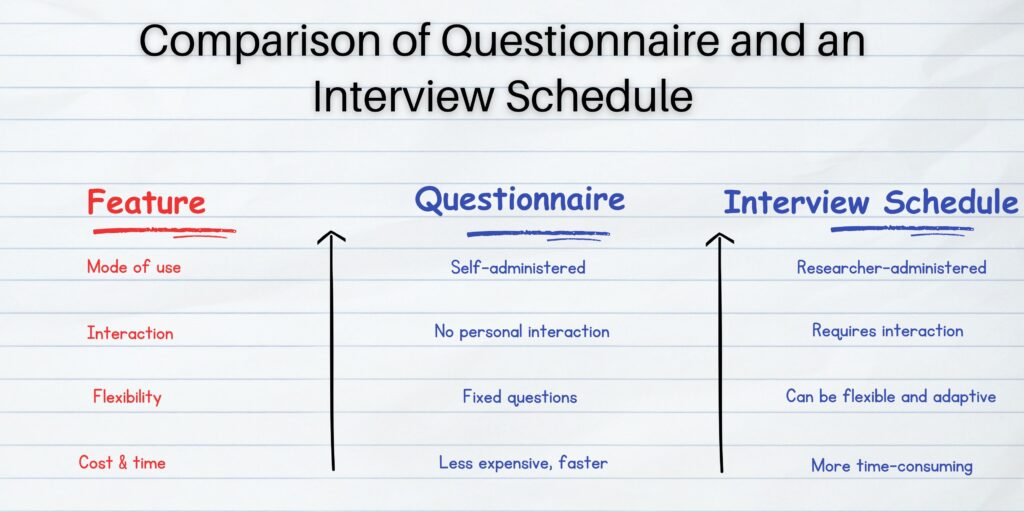Understanding Questionnaires and Interview Schedules for Better Research Outcomes
Kenfra Research - Nandhini2025-07-22T17:25:28+05:30When conducting research the process of collecting accurate relevant and reliable data begins with designing your data collection tools especially Questionnaires and Interview Schedules properly. These tools are essential for gathering insights directly from participants, whether you’re studying behaviours, attitudes, or experiences. A questionnaire allows for structured, consistent responses—especially useful in large surveys—while an interview schedule provides flexibility for deeper, more personal insights during conversations. Both methods serve different research goals but share one common requirement: thoughtful, intentional design. Questionnaires and Interview Schedules must be carefully planned to ensure the questions guide participants clearly and effectively toward meaningful responses.
The way you frame your questions can significantly affect the quality of your data. Poorly worded or confusing questions may result in vague or biased answers, reducing the overall validity of your study. That’s why it’s important to focus on clarity, relevance, and flow when developing your research instruments. Whether your study is quantitative, qualitative, or mixed-method, designing strong data collection tools helps ensure that the responses you receive truly reflect the information you need. In the following sections, we’ll explore how to design questionnaires and interview schedules effectively, with practical tips and examples.

What is a Questionnaire?
A questionnaire is a set of written questions designed to gather information from respondents. It’s usually self-administered, meaning participants fill it out on their own — online or on paper.
What is an Interview Schedule?
An interview schedule is a pre-planned set of questions used by a researcher or interviewer while conducting face-to-face, telephonic, or online interviews. Unlike questionnaires, it involves direct interaction between the researcher and the participant.
Steps to Design a Good Questionnaire
1. Define the Purpose
Start with why you’re collecting data.
- What do you want to find out?
- Who are your respondents?
This helps decide what kind of questions to ask.
2. Identify the Target Audience
Know your respondents’:
- Age group
- Language proficiency
- Background knowledge
Design language and structure accordingly.
3. Choose Question Types
You can include:
- Closed-ended questions (Yes/No, multiple choice, Likert scale)
- Open-ended questions (Write your own answer)
Example:
- Closed: “Do you use social media daily? Yes / No”
- Open: “Why do you prefer Instagram over Facebook?”
4. Keep Questions Clear and Neutral
Avoid leading or biased questions.
“Don’t you think our app is the best?”
“How would you rate your experience with our app?”
5. Use Logical Order
Group related questions together. Start with easy and general questions, then move to specific or sensitive ones.
6. Pilot Test Your Questionnaire
Before sharing it widely, test it with 5–10 people. This helps catch:
- Confusing questions
- Formatting issues
- Technical problems (for online forms)
7. Keep It Short and Focused
Avoid overwhelming respondents. Stick to the most essential questions. Respect their time.
8. Include a Thank You Note and Consent
Always start with a brief introduction, explain the purpose, and end with a thank you message. Ensure informed consent is obtained.
How to Design an Effective Interview Schedule
An interview schedule needs both structure and flexibility. Follow these steps:
1. Define the Objective
What are you trying to explore through this interview? Interviews are good for understanding opinions, feelings, and experiences.
2. Choose Interview Type
- Structured: Fixed set of questions
- Semi-structured: Some fixed, some flexible
- Unstructured: Open, free-flowing conversation
3. Prepare Open-Ended Questions
Use “what,” “how,” and “why” questions.
Examples:
- “What challenges do you face while working remotely?”
- “How do you manage your time in online learning?”
4. Avoid Leading or Yes/No Questions
Let the participant explain in their own words.
“Wasn’t the new software too slow for you?”
“How did you find the performance of the new software?”
5. Add Probing Prompts
Prepare follow-up prompts like:
- “Can you tell me more about that?”
- “What happened next?”
- “Why do you think that is?”
6. Practice Delivery
Test your schedule with a peer or mentor. Practice asking questions naturally while keeping the tone friendly and professional.
7. Get Consent and Ensure Confidentiality
Start with an introduction and get verbal or written consent. Reassure participants that their responses will remain confidential.
Tips for Both Tools
- Use simple, jargon-free language
- Avoid double-barreled questions (asking two things in one)
“Do you think the training was useful and well-organized?” - Watch out for bias in both question wording and delivery
- Always give the respondent the option to skip or say “prefer not to answer”

Example: Questionnaire vs. Interview Questions
Topic: Online Learning Challenges
- Questionnaire (Closed):
How often do you experience internet issues during online classes?- Rarely
- Sometimes
- Often
- Always
- Interview Question (Open):
Can you describe a situation when poor internet affected your learning experience?
Final Thoughts
Designing effective data collection tools is a critical step in any research process. It goes beyond simply writing a list of questions — it involves understanding your research objectives, knowing your participants, and choosing the right format to collect meaningful information. Using well-structured Questionnaires and Interview Schedules allows you to gather data that is not only relevant but also reliable and valid across different contexts and participants. These tools help bridge the gap between theoretical frameworks and real-world experiences by capturing opinions, behaviours, and insights in a systematic manner. Whether you’re a PhD scholar preparing for extensive fieldwork or a student starting your first project, taking the time to thoughtfully develop your data collection instruments will significantly enhance the overall quality, accuracy, and impact of your research outcomes.
From framing the right questions to reviewing your final draft — Kenfra supports you at every step of your research journey.







Leave a Reply